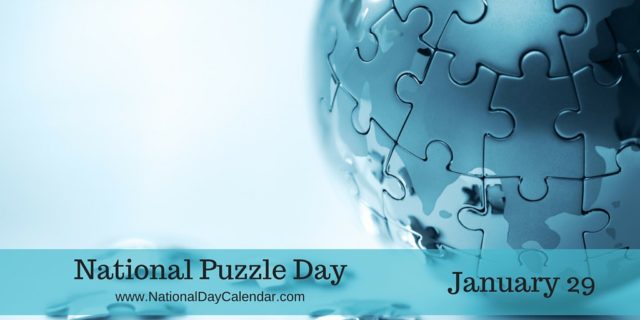
Exercise your problem brain with a puzzle. January 29th is National Puzzle Day.
Whether it’s a crossword, jigsaw, trivia, word searches, brain teasers or Soduku, puzzles put our minds to work.
Studies have found that when we work on a jigsaw puzzle, we use both sides of the brain, and spending time daily working on puzzles improves memory, cognitive function and problem-solving skills.
Word searches and crossword puzzles have the obvious benefit of increasing vocabulary and language skills.
Sudoku, a puzzle sequencing a set of numbers on a grid, exercises the brain as well. By testing memory and logical thinking, this puzzle stimulates the brain and can improve number skills.
The bottom line is, puzzles stimulate the brain, keeping it active and practicing its skills.
Started in 2002 by Jodi Jill, National Puzzle Day was created as a way to share her enjoyment of puzzles. As a syndicated newspaper puzzle maker and professional quiz maker, Jodi Jill developed classroom lesson plans especially for National Puzzle Day and the popularity has grown year after year.
- The inventor of the Rubik’s Cube didn’t realize he’d built a puzzle until he scrambled it the first time and tried to restore it.
- The day before the 1996 U.S. presidential election, the NYT Crossword contained the clue “Lead story in tomorrow’s newspaper,” the puzzle was built so that both electoral outcomes were correct answers, requiring 7 other clues to have dual responses.
- Will Shortz, the New York Times crossword puzzle editor, is the only person in the world to have a degree in enigmatology, the study of puzzles
- In the 1920s, people feared that crossword puzzles would contribute to illiteracy.
- In 1944, by a huge coincidence, a crossword puzzle was printed with answers all containing D-Day operation code names, which sent MI-5 into a panic thinking their invasion plans had been discovered.
- In 1980, Ronald Graham offered a prize of $100 for anyone who could solve his “Boolean Pythagorean Triples Problem.” In 2016, three computer scientists solved the puzzle, using a supercomputer over the course of 2 days, and came out with a proof that takes up 200TB of storage space.
- The first Jigsaw Puzzle was created in 1767 by cartographer James Spilsbury who cut up a wood map with each country being its own piece to help teach geography.
- The term “Jigsaw” comes from puzzles being cut from wood by a Jigsaw tool.
- Most piece counts listed are not actual. Piece counts are rounded down to the nearest even number. For example the most common 1,000 piece puzzle layout is usually about 1.026 pieces and 500 piece puzzles are usually about 513 pieces.
Sources:












